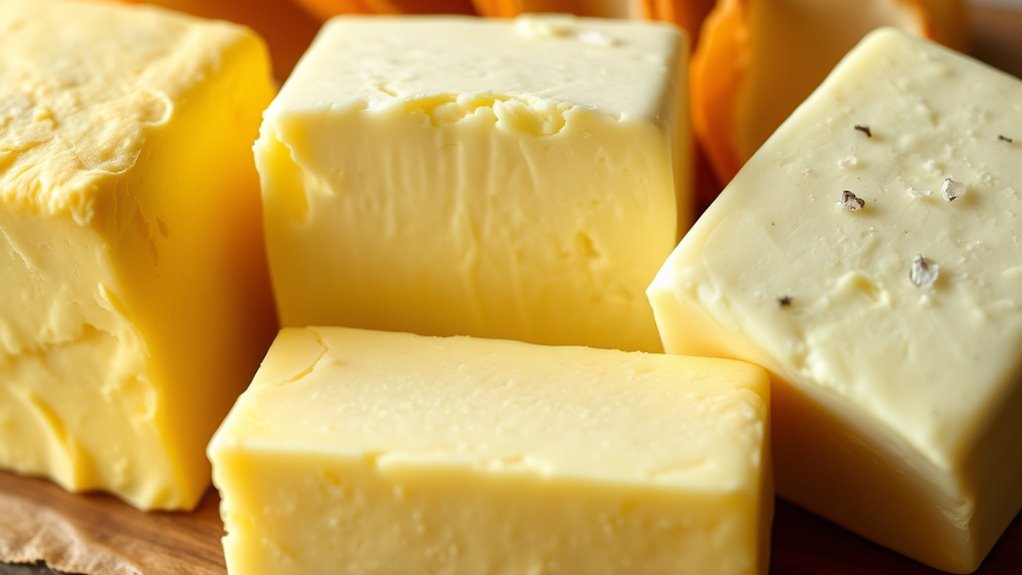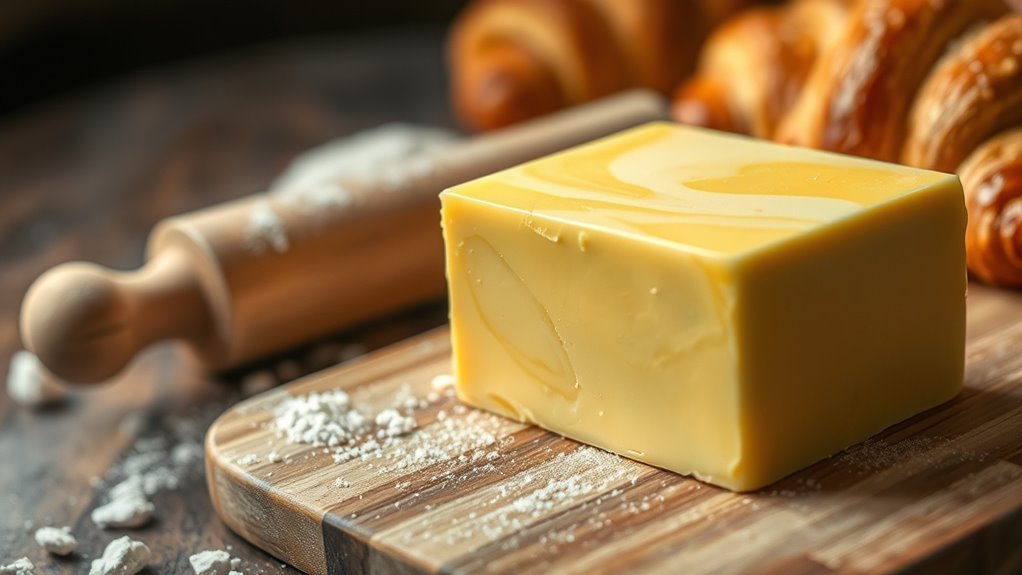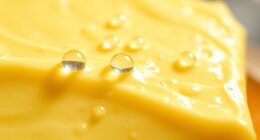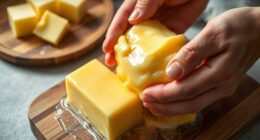For the best laminated pastries, choose high-quality butter with a fat content between 82% and 85%. This guarantees distinct, flaky layers that elevate your pastries’ texture and flavor. Store your butter properly in the coldest part of the fridge or freeze it for long-term use. Use it cold but pliable to maintain layers during lamination. With the right butter and techniques, you’ll create extraordinary pastries that leave everyone wanting more. Discover more tips to perfect your baking!
Key Takeaways
- Choose butter with 82% to 85% fat content for optimal flakiness and layering in laminated pastries.
- Use high-quality butter for enhanced flavor, texture, and overall pastry appearance.
- Store butter tightly wrapped in the coldest part of the refrigerator to prevent odor absorption.
- Use cold but pliable butter for lamination to achieve distinct layers without blending.
- Properly thaw frozen butter in the fridge to maintain its quality before baking.

Have you ever wondered why the right butter makes all the difference in laminated pastries? The answer lies in its quality and how it interacts with the dough during the lamination process. When you choose high-quality butter, you’re not just picking a flavor; you’re selecting a key ingredient that can elevate your pastries from good to extraordinary. The fat content, flavor, and texture all play vital roles in how your pastries turn out. Using butter that meets quality standards ensures that you get that rich, flaky texture that everyone craves.
One of the most important aspects to consider is the butter’s fat content. For laminated pastries, you ideally want butter with a fat content of around 82% to 85%. This higher fat percentage contributes to a flakier result because it helps create those distinct layers when you fold the dough. Lower-fat options might work, but they can lead to denser, less appealing results. So, next time you’re at the store, don’t skimp on quality; your pastries deserve it.
Choosing butter with 82% to 85% fat content is crucial for achieving flaky, layered laminated pastries. Quality matters!
Storage techniques also matter when it comes to the butter you choose. Properly storing your butter ensures that it maintains its freshness and flavor, which is crucial for your pastries. Keep it in the coldest part of your refrigerator and always wrap it tightly to prevent it from absorbing any unwanted odors. If you’re not using your butter right away, consider freezing it. When frozen, it can last for months without losing its quality. Just remember to thaw it in the fridge before you start your baking project.
When you’re ready to bake, make sure your butter is cold but pliable. This temperature is essential for achieving the right lamination. If it’s too soft, the layers will meld together, and you won’t get that beautiful, flaky texture. If it’s too hard, it won’t incorporate well into the dough. Finding that sweet spot can make or break your pastry.
Frequently Asked Questions
Can I Use Margarine Instead of Butter for Laminated Pastries?
You can use margarine instead of butter for laminated pastries, but it won’t yield the same flaky texture and rich flavor. Margarine vs butter often comes down to taste and performance in baking. While margarine might seem like a healthier pastry option, the lack of butter’s fat content can affect your pastry’s rise and layers. If you’re aiming for the best results, sticking with butter is usually the way to go.
How Does Butter Temperature Affect Lamination?
Butter temperature plays a vital role in lamination; for instance, butter melts at around 90-95°F (32-35°C). If it’s too warm, it can leak out during rolling, compromising layers. You need to maintain proper temperature control techniques to keep the butter pliable but firm. Ideally, you want the butter to be slightly colder than the dough. This balance ensures that as you laminate, the layers remain distinct and flaky, leading to a successful pastry.
What Is the Best Way to Store Leftover Laminated Pastry Dough?
To store leftover laminated pastry dough, wrap it tightly in plastic wrap or an airtight container to prevent drying out. If you won’t use it within a couple of days, consider freezing it. For freezing, cut the dough into portions, wrap each piece individually, and place them in a freezer bag. Label with the date, and you’ll have ready-to-use dough anytime. Remember to thaw it in the fridge before rolling out!
Can I Mix Different Types of Butter for Better Results?
Yes, you can mix different types of butter for better results! In fact, studies show that blending butters can enhance flavor consistency in your pastries. By combining a higher-fat butter with a lower-fat option, you can achieve a desirable texture while boosting the flavor profile. Just be mindful of the ratios, as too much variation can affect the overall quality. Experimenting with butter blending can lead to deliciously unique pastries!
How Does the Fat Content of Butter Influence Pastry Texture?
The fat content of butter plays a vital role in pastry texture. Higher butter fat content results in greater pastry tenderness, creating a flaky, rich texture that melts in your mouth. If you use butter with lower fat content, you might end up with a tougher pastry. For the best results, aim for butter that has at least 80% fat, ensuring your pastries achieve that desired lightness and buttery flavor you’re looking for.
Conclusion
Choosing the right butter for your laminated pastries is like picking the perfect partner for a dance; it makes all the difference in the performance. The rich flavor and ideal fat content elevate your creations to a level of flaky perfection that’s simply unforgettable. So, as you begin your pastry-making journey, remember that the right butter is your secret ingredient. With each flake, you’re not just baking; you’re crafting memories that’ll linger long after the last bite.









